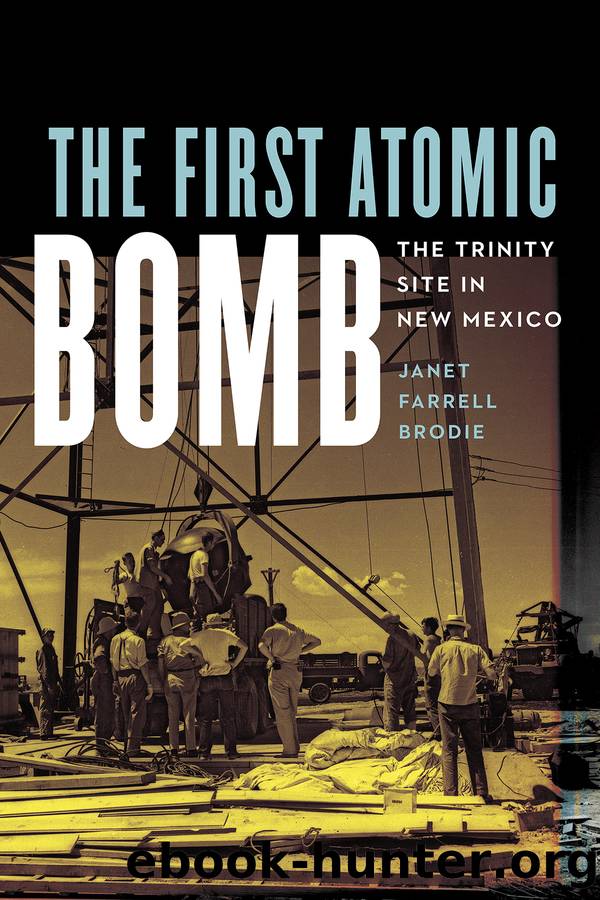The First Atomic Bomb: the Trinity Site in New Mexico by Janet Farrell Brodie

Author:Janet Farrell Brodie [Brodie, Janet Farrell]
Language: eng
Format: epub
Tags: HIS036060 HISTORY / United States / 20th Century, HIS036130 HISTORY / United States / State & Local / Southwest (AZ, NM, OK, TX), HIS027030 HISTORY / Military / Nuclear Warfare
Publisher: Nebraska
The Atomic Energy Commission and the Trinity Site
In January 1947, after much contentious, even acrimonious debate within Congress and the country at large, the U.S. military was required to relinquish control over the nationâs nuclear energy production facilities and its nuclear stockpile and transfer everything to the civilian Atomic Energy Commission, created by Congress and signed into law by Truman in August 1946. Executive Order 9816 required that on January 1, 1947, âtitle to plants, facilities, land, etc. then in possession or custody of the Manhattan Engineer District would be transferred to the [Atomic Energy] Commission.â80
Atomic Energy Commission (AEC) commissioners informed General Groves in early December that as of January 1, 1947, they would take over the atomic project, and all property and functions were to be transferred to the AEC by that date. The AEC would then âretransfer such property and functions deemed more appropriate for armed services control.â81 Groves and Kenneth D. Nichols objected, arguing that certain properties, including all ordnance works, the Sandia Base at Albuquerque, and âall weapons storage sites,â should not be transferred even temporarily; furthermore, âthe raw materials function should remain under Army control . . . and intelligence operations and records should be transferred directly to the new Central Intelligence Group.â82 The commission disagreed, and even though Nichols met with AEC officials several times in December, the AEC commissioners would not relinquish their new power of total civilian custody of atomic weapons. Thus, the AEC assumed oversight and control of researching, manufacturing, and testing nuclear weapons in a complex scattered over thirteen states, with two thousand military employees, four thousand government employees, and thirty-eight thousand civilian employees or contractors.83 In addition to Los Alamos, Hanford, Oak Ridge, and the scores of lesser-known and smaller materials-procuring, producing, and processing sites, the AEC gained authority over the acreage at the Trinity site.
The civilians appointed by President Truman to manage the AEC found fierce resistance not only from Groves and other Manhattan Project military officials but also from within the War Department (soon to be the Department of Defense). Eventually the AEC mitigated some of the animosities by adding a Military Liaison Committee, but conflicts continued especially in the early postwar years as many interested parties wrangled over access to and control of nuclear weapons and the nuclear weapons complex. In their desire for a complete break with the Manhattan Project personnel, the AEC rebuffed Grovesâs suggested names for the first members of the AECâs Military Liaison Committee. Groves also tried to designate Kenneth Nichols as a liaison between him and the AEC, but that, too, fell through. In one of the ironies that sometimes happens in such antagonisms, the AEC was housed in the New War Department Building in Washington DC with offices adjacent to Grovesâs headquarters.84
As the AEC prepared to take control of all atomic bomb sites and materials from the army in the official transfer of power in January 1947, the army worked to secure an exception for the Trinity test site area.
Download
This site does not store any files on its server. We only index and link to content provided by other sites. Please contact the content providers to delete copyright contents if any and email us, we'll remove relevant links or contents immediately.
| Biological & Chemical | Conventional |
| Nuclear |
The Radium Girls by Kate Moore(11901)
100 Deadly Skills by Clint Emerson(4824)
Rise and Kill First by Ronen Bergman(4688)
The Templars by Dan Jones(4615)
The Doomsday Machine by Daniel Ellsberg(4399)
The Rape of Nanking by Iris Chang(4125)
Killing England by Bill O'Reilly(3940)
Hitler in Los Angeles by Steven J. Ross(3891)
Stalin by Stephen Kotkin(3865)
12 Strong by Doug Stanton(3497)
Hitler's Monsters by Eric Kurlander(3256)
Blood and Sand by Alex Von Tunzelmann(3121)
Darkest Hour by Anthony McCarten(3058)
The Code Book by Simon Singh(3057)
The Art of War Visualized by Jessica Hagy(2932)
Hitler's Flying Saucers: A Guide to German Flying Discs of the Second World War by Stevens Henry(2700)
Babylon's Ark by Lawrence Anthony(2575)
The Second World Wars by Victor Davis Hanson(2467)
Tobruk by Peter Fitzsimons(2433)
